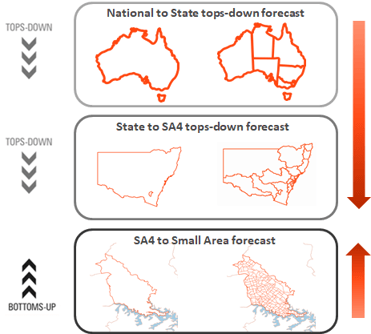A brief description of 'tops down methodology'
The tops-down forecasts are used to constrain the Small Area Forecasts that you subscribe to. It is an important feature of our forecasts that ensures we have a holistic view of population growth and adds credibility to our results. If you looked at individual regions in isolation, an easy trap to fall into would be to over forecast an area and not consider the factors at play in adjacent areas (i.e. overall demand).
Our unique approach
Our approach to developing SAFi forecasts is to combine both tops-down and bottoms-up modelling techniques. The tops-down model limits the total amount of population within the context of realistic demographic limits (a view of this is particularly important as we assess the impact of Covid). We set tops-down constraints at the National, State and Regional (SA4) level.

To produce such geographically granular forecasts it is important to then consider development activity that’s happening on the ground. The bottoms-up model takes into account changes occurring to housing supply at the local level, as well as relevant typologies of migration and area-specific birth rates and death rates.
Once combined (a process known as amelioration modelling) we produce forecasts that are driven by both macro demographic changes and validated by a detailed understanding of residential development activity. Thus providing you with reliable granular forecasts that incorporate detailed research and knowledge of place.
Our forecasting rhythm
We continually monitor demographic patterns and new data being released by the Australian Bureau of Statistics. When significant new data is released we will update our National forecasts and assess how our forecasts will be impacted by this information. These updates are then cascaded down to smaller geographic areas and incorporated into new forecast releases.
